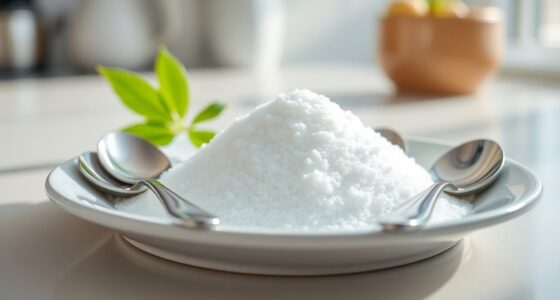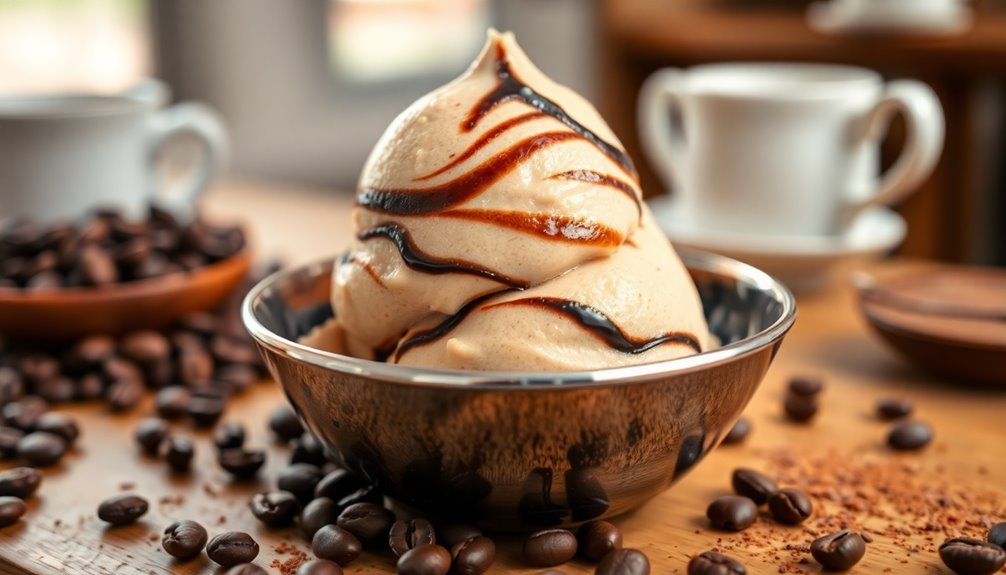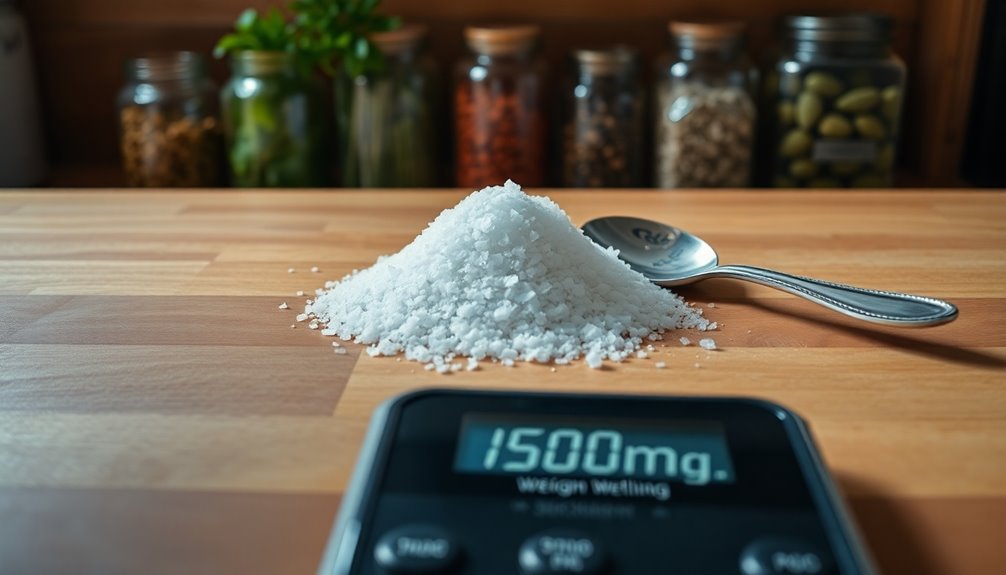Yerba mate’s tannin content varies considerably based on several factors. You’ll find levels ranging from about 5. 58 mg/g in green leaves to around 32. 04 mg/g in processed products. The tannin amount can change due to the maturity of the leaves, processing methods, and even environmental conditions like sunlight and soil type. Brewing methods also affect how much tannin you extract, with higher temperatures and longer infusion times leading to greater concentrations. If you’re curious to learn more about how these factors play into yerba mate’s unique profile, there’s a lot more interesting information waiting for you. Understanding how tannin levels affect yerba mate can enhance your appreciation of this traditional beverage. Not only do these compounds contribute to the astringency and bitterness of the drink, but they can also influence its overall health benefits and flavor profile. By exploring different varieties and preparation techniques, you can discover how these elements interact to create a uniquely satisfying experience with each cup.
Key Takeaways
- Tannin levels in yerba mate range from 5.58 mg/g in green leaves to 32.04 mg/g in conventional products.
- Processing methods, leaf maturity, and storage conditions significantly influence tannin concentrations.
- Higher tannin concentrations are associated with darker leaf colors and specific environmental factors.
- Brewing methods affect tannin extraction; single brews yield the highest levels compared to double brews.
- Tannins in yerba mate offer health benefits, including antioxidant properties and potential chronic disease risk reduction.
Understanding Tannins in Yerba Mate
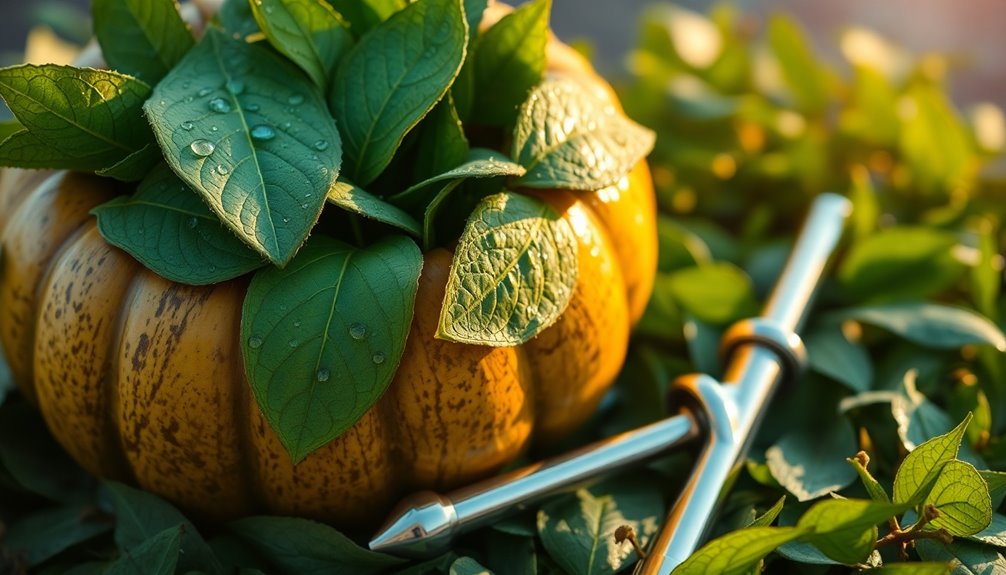
When you sip yerba mate, you're not just enjoying a unique flavor; you're also experiencing the effects of tannins. The tannin content varies considerably, ranging from 5.58 mg/g in green leaves to 32.04 mg/g in conventional products. This variability stems from processing methods and the maturity of the leaves.
You'll notice that higher tannin concentrations often correlate with darker leaf colors, linking color parameters to tannin levels. Tannins contribute to the astringency and overall flavor profile of yerba mate, with variations detectable through colorimetric assays.
During processing, specific moisture conditions can increase tannin concentration, especially post-bleaching. Advanced techniques, like Partial Least Square analysis using reflectance spectra, have shown promise in predicting tannin content based on these color parameters.
Factors Affecting Tannin Levels

While various factors influence tannin levels in yerba mate, the most notable ones include processing methods, environmental conditions, and the maturity of the leaves.
You'll notice that tannin content can vary widely, from 5.58 mg/g in green leaves to 32.04 mg/g in conventionally processed ones.
Consider these key influences:
- Processing methods: Techniques like bleaching and drying affect tannin levels considerably.
- Leaf colors: Darker leaves typically have higher tannin concentrations, related to maturity.
- Environmental conditions: Regions with more sunlight lead to greater tannin accumulation, impacting overall flavor. Additionally, certain teas may interact with medications, which highlights the importance of understanding tannin levels for health considerations.
Health Benefits of Tannins

Tannins in yerba mate not only influence the drink's flavor and astringency but also offer several health benefits that make it a popular choice among wellness enthusiasts.
These bioactive compounds boast antioxidant properties, helping you combat oxidative stress and lower the risk of chronic diseases. If you're looking to manage your weight, tannins may aid in promoting feelings of fullness, potentially influencing fat metabolism.
Furthermore, the anti-inflammatory effects of tannins contribute to better cardiovascular health, making your heart stronger. Their antifungal and antiviral properties also suggest that tannins can bolster your immune system, keeping you healthier overall.
Tannin Measurement Techniques
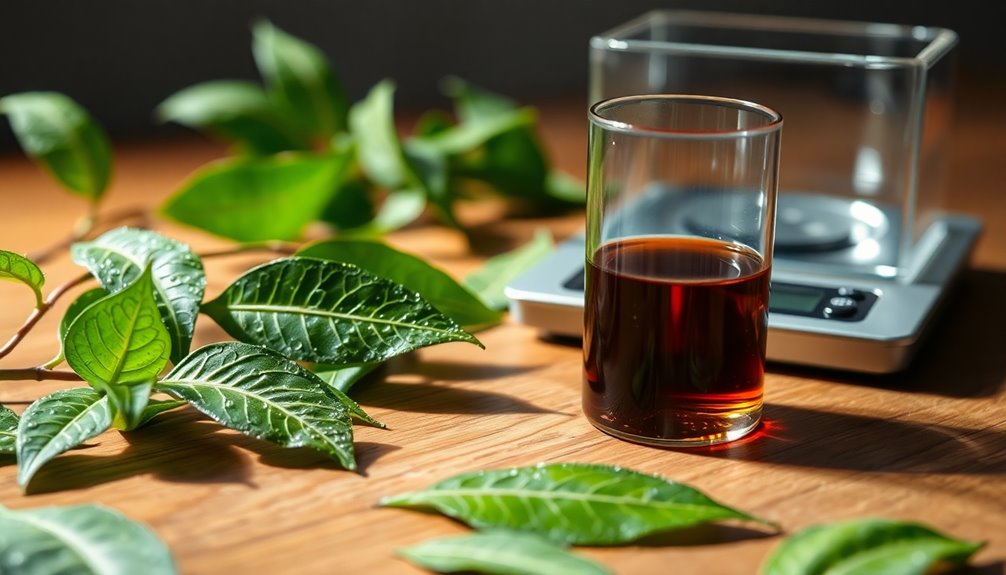
When measuring tannins in yerba mate, you'll find various techniques that can provide valuable insights.
Colorimetric assays, like the vanillin reaction, and spectroscopic methods play significant roles in determining tannin content.
Understanding the factors contributing to variability in tannin levels can enhance your appreciation of yerba mate's unique qualities.
Colorimetric Assays Overview
Colorimetric assays offer a reliable method for measuring tannin content in yerba mate, as they utilize the vanillin reaction to quantify total tannins extracted with methyl alcohol.
These assays are essential for evaluating various factors affecting yerba mate's characteristics:
- Tannin content can vary considerably from 5.58 mg/g in green leaves to 32.04 mg/g in conventional samples.
- Color parameters, like La*, help predict tannin levels, showing a strong correlation (R = 0.92).
- Higher tannin concentrations often correlate with darker leaf colors, impacting astringency and flavor profile.
Spectroscopic Analysis Methods
While various methods exist for measuring tannin content in yerba mate, spectroscopic analysis techniques stand out for their speed and reliability. UV-Vis spectroscopy allows you to analyze multiple yerba mate extracts simultaneously, providing precise tannin concentrations. Additionally, second derivative reflectance spectroscopy enhances accuracy and sensitivity over traditional methods.
| Method | Key Feature |
|---|---|
| UV-Vis Spectroscopy | Rapid analysis of samples |
| Second Derivative Reflectance Spectroscopy | Improved accuracy and sensitivity |
| PLS Modeling | High correlation with color parameters |
Colorimetric assays can also be employed, but combining these spectroscopic methods with PLS modeling shows promising results in predicting tannin content effectively.
Tannin Content Variability Factors
Understanding tannin content variability is essential for appreciating yerba mate's unique flavor and astringency. Several factors influence this variability, including:
- Leaf maturity: Younger leaves tend to have lower tannin content.
- Processing methods: Techniques such as bleaching can increase tannin levels due to temperature and moisture effects.
- Environmental conditions: Higher luminosity regions yield yerba mate with greater tannin concentrations.
Colorimetric assays are frequently used to measure tannin content, shedding light on the beverage's astringency and flavor profile.
Additionally, Partial Least Square (PLS) analysis, utilizing color parameters (L*, a*, b*), effectively predicts tannin levels, achieving a remarkable correlation coefficient of R = 0.92, particularly in conventional samples.
Brewing Methods and Tannin Release
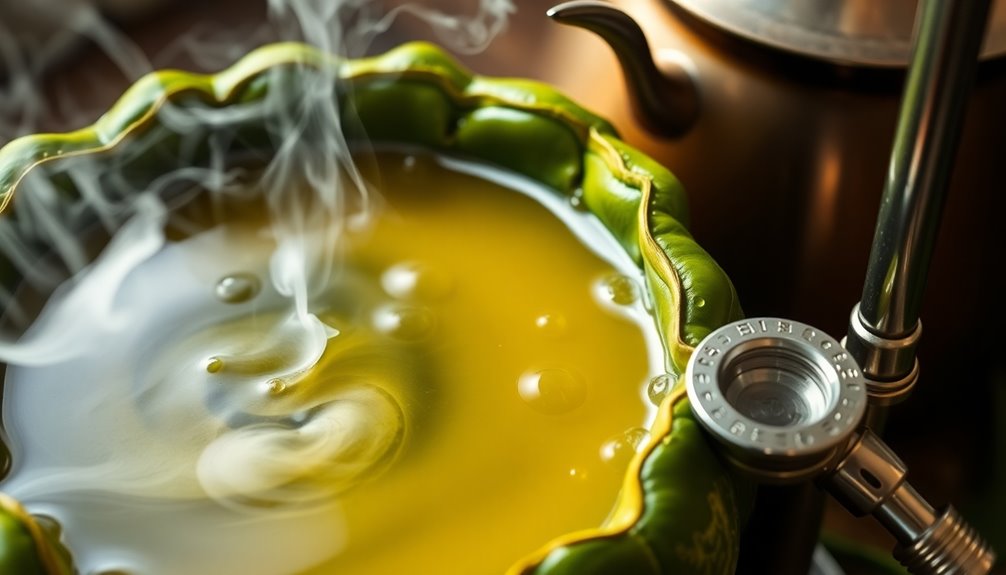
How do brewing methods affect the release of tannins in yerba mate? The way you brew yerba mate plays a considerable role in the tannin content and flavor profile of your drink. Single brews typically extract higher tannin levels than double brews. Additionally, brewing at lower temperatures (70°C) maximizes polyphenol content and antioxidant activity, while higher temperatures (100°C) boost tannin concentration. The infusion time also matters—brewing for 5 to 10 minutes can considerably alter extracted tannin levels.
| Brewing Method | Tannin Content (mg/g) | Flavor Profile |
|---|---|---|
| Low Temp (70°C) | Higher | Milder, smoother taste |
| High Temp (100°C) | Higher | Bolder, more astringent |
| Single Brew | Highest | Intense, rich flavor |
| Double Brew | Lower | Softer, less intense |
Future Research Directions on Tannins

As you explore future research directions on tannins in yerba mate, consider analyzing how different processing methods affect tannin variation.
You might also investigate the health benefits of these compounds, especially their impact on gut health.
Additionally, studying the relationship between tannin levels and brewing conditions can enhance yerba mate's flavor profile.
Tannin Variation Analysis
Although tannin content in yerba mate varies widely due to several factors, future research can enhance our understanding of this variability.
By investigating the interplay of different elements, you can uncover valuable insights into tannin concentrations. Consider focusing on:
- The impact of processing methods on tannin levels.
- Environmental factors, such as sunlight exposure, affecting growth conditions.
- Utilizing Partial Least Square analysis with color parameters to predict tannin content.
These studies could reveal how tannin content influences flavor and health benefits, enabling you to appreciate yerba mate more fully.
Understanding the connections between these factors will help refine yerba mate production, leading to improved quality and consumer satisfaction.
Processing Impact Studies
Understanding the impact of processing methods on tannin content in yerba mate is essential for developing products that meet consumer preferences.
The drying process and storage conditions greatly influence tannin levels, affecting the flavor profiles you experience. Research shows that higher tannin concentrations are often linked to specific processing methods and the maturity of leaves, particularly darker leaves.
Environmental factors, such as luminosity, also play a role in tannin variability, suggesting that yerba mate's quality can differ based on growing conditions.
Future studies should examine how these processing techniques relate to tannin levels, ultimately enhancing flavor and ensuring better consumer acceptance.
Health Benefits Exploration
While many enjoy yerba mate for its rich flavor and caffeine boost, recent studies hint at its potential health benefits, particularly those linked to tannins.
The tannin content varies greatly, influencing not only taste but also health effects. Research suggests that these compounds might play a role in:
- Antifungal and antiviral properties
- Antidiabetic benefits
- Chronic disease prevention
As you explore yerba mate, consider the interactions between tannins and other bioactive compounds.
Understanding these relationships can enhance quality assessment methods and guide future research. With a deeper insight into tannin levels, you could reveal new avenues for health benefits, emphasizing the importance of yerba mate not just as a beverage, but as a potential tool for wellness.
Frequently Asked Questions
Is Yerba Mate High in Tannins?
Yerba mate can be high in tannins, depending on the specific leaves and processing methods used.
If you're enjoying traditional yerba mate, you might notice a more astringent taste due to these compounds. Tannins contribute to the overall flavor profile and sensory experience, so when you sip on yerba mate, you're likely tasting those unique characteristics.
Just remember, the tannin levels can vary considerably based on factors like leaf maturity and environmental conditions.
What Drink Has the Most Tannins?
When you're curious about which drink has the most tannins, black tea often tops the list, with levels ranging from 30 to 50 mg/g depending on the type and brewing method.
However, red wines, especially those crafted from Cabernet Sauvignon grapes, can exceed 1,000 mg/L, making them incredibly rich in tannins.
This high tannin content contributes to their distinctive mouthfeel and astringency, influencing your overall tasting experience.
Is It OK to Drink Yerba Mate Everyday?
Isn't it tempting to sip on something that feels both invigorating and soothing? Drinking yerba mate daily can be safe for most, offering health perks like antioxidants and potential weight management support.
However, moderation is key; sticking to 1-3 servings a day helps you enjoy the benefits while minimizing risks like anxiety or cancer concerns.
If you're sensitive to caffeine or have health issues, it's wise to consult a healthcare professional first.
Which Tea Has the Highest Tannins?
If you're curious about which tea has the highest tannins, black tea takes the crown. It often contains tannin levels averaging around 15-30% of its dry weight, depending on the variety and brewing method.
In comparison, green tea has lower tannin concentrations, typically around 6-8%, while oolong tea falls in between.
Conclusion
To sum up, yerba mate's tannin content contributes to its unique flavor and potential health benefits, so it's worth considering as part of your wellness routine. You might worry about tannins causing digestive issues, but moderation is key. By understanding how to brew yerba mate properly and choosing the right blend, you can enjoy its richness without discomfort. Embrace the journey of exploring yerba mate, and you might just find a delightful addition to your daily ritual.




